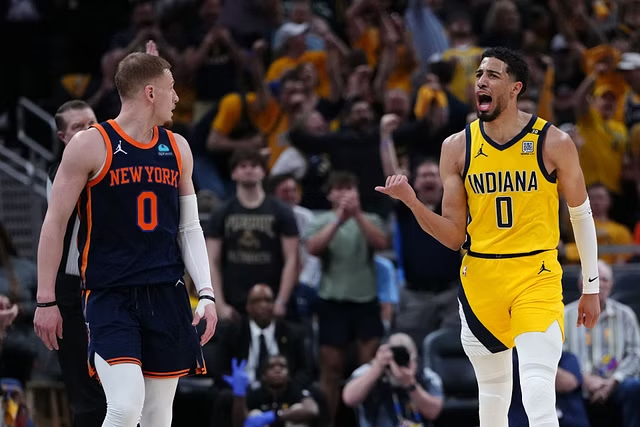Introduction
knicks vs pacers match player stats? The New York Knicks and the Indiana Pacers, two storied franchises in the NBA, have faced off countless times, creating a rich history of competition. Each game between these teams brings with it a blend of skill, strategy, and raw athleticism. In this article, we delve into the detailed player stats of a recent matchup, examining the performances that defined the game.
Team Overview
Before diving into individual performances, it’s essential to understand the broader context of both teams.
New York Knicks
The Knicks, based in the bustling metropolis of New York City, have a storied history and a passionate fan base. Known for their gritty playstyle, the Knicks emphasize defense and teamwork. Key players often include a mix of seasoned veterans and young talent, creating a dynamic and unpredictable team.
Indiana Pacers
The Pacers, hailing from Indianapolis, are known for their balanced and disciplined approach to the game. The team often prides itself on strong defensive capabilities and efficient offensive play. The Pacers have a reputation for developing young talent and integrating them seamlessly into their system.
Key Player Performances
New York Knicks
1. Julius Randle
- Points: 27
- Rebounds: 12
- Assists: 5
- Field Goal Percentage: 48%
Julius Randle continues to be the cornerstone of the Knicks’ offense. His ability to score both inside and outside makes him a versatile threat. In this game, Randle’s physicality and determination were on full display, as he dominated the paint and also showcased his improved shooting range.
2. RJ Barrett
- Points: 22
- Rebounds: 7
- Assists: 3
- Field Goal Percentage: 45%
RJ Barrett, the young and promising wing, displayed his all-around game. His scoring was efficient, and he made significant contributions on both ends of the floor. Barrett’s defensive versatility and offensive aggression make him a key player for the Knicks.
3. Derrick Rose
- Points: 15
- Rebounds: 4
- Assists: 6
- Field Goal Percentage: 50%
The veteran point guard, Derrick Rose, brought experience and poise to the game. His ability to control the tempo and make crucial plays in the clutch was invaluable. Rose’s leadership and scoring ability off the bench provided a significant boost for the Knicks.
4. Mitchell Robinson
- Points: 10
- Rebounds: 15
- Blocks: 3
- Field Goal Percentage: 60%
Mitchell Robinson’s presence in the paint was a game-changer. His rebounding and shot-blocking skills anchored the Knicks’ defense. Robinson’s ability to finish around the rim and protect the paint was critical in limiting the Pacers’ scoring opportunities.
5. Immanuel Quickley
- Points: 12
- Rebounds: 3
- Assists: 4
- Field Goal Percentage: 42%
Immanuel Quickley’s energy and scoring off the bench were pivotal. His quickness and shooting ability provided a spark for the Knicks, and his defensive efforts helped contain the Pacers’ backcourt.
Indiana Pacers
1. Domantas Sabonis
- Points: 25
- Rebounds: 14
- Assists: 7
- Field Goal Percentage: 55%
Domantas Sabonis was the focal point of the Pacers’ offense. His ability to score in the post, facilitate from the high post, and rebound effectively made him a constant threat. Sabonis’ versatility and high basketball IQ were evident throughout the game.
2. Malcolm Brogdon
- Points: 20
- Rebounds: 5
- Assists: 8
- Field Goal Percentage: 47%
Malcolm Brogdon’s steady play at the point guard position was crucial for the Pacers. His scoring, playmaking, and defensive capabilities provided balance to the team. Brogdon’s ability to penetrate and distribute the ball kept the Knicks’ defense on its toes.
3. Caris LeVert
- Points: 18
- Rebounds: 4
- Assists: 3
- Field Goal Percentage: 44%
Caris LeVert’s scoring prowess was on display as he consistently found ways to get to the basket and score. His ability to create his own shot and contribute defensively added a significant dimension to the Pacers’ game plan.
4. Myles Turner
- Points: 12
- Rebounds: 10
- Blocks: 4
- Field Goal Percentage: 50%
Myles Turner’s shot-blocking and rebounding were vital for the Pacers. His defensive presence in the paint deterred the Knicks from driving to the basket. Turner’s ability to stretch the floor with his shooting also added a valuable aspect to the Pacers’ offense.
5. T.J. Warren
- Points: 14
- Rebounds: 6
- Assists: 2
- Field Goal Percentage: 48%
T.J. Warren’s scoring and defensive versatility made him an important player for the Pacers. His mid-range game and ability to guard multiple positions provided the Pacers with flexibility on both ends of the court.
Game Analysis
First Half
The first half of the game was marked by intense defensive efforts from both teams. The Knicks came out strong, with Julius Randle and RJ Barrett leading the charge. Randle’s dominance in the paint and Barrett’s perimeter shooting helped the Knicks establish an early lead. On the defensive end, Mitchell Robinson’s shot-blocking and rebounding were crucial in limiting the Pacers’ second-chance opportunities.
The Pacers responded with a balanced attack, led by Domantas Sabonis and Malcolm Brogdon. Sabonis’ ability to score and facilitate from the post kept the Pacers in the game. Brogdon’s penetration and playmaking created open shots for his teammates, and Caris LeVert’s scoring off the dribble added to the Pacers’ offensive firepower.
Second Half
The second half saw the Pacers making adjustments and tightening their defense. Myles Turner’s shot-blocking and defensive presence in the paint made it difficult for the Knicks to score inside. Turner also contributed offensively, stretching the floor with his shooting.
The Knicks relied on their bench depth, with Derrick Rose and Immanuel Quickley providing a spark. Rose’s veteran leadership and Quickley’s scoring kept the Knicks competitive. However, the Pacers’ balanced attack, with key contributions from T.J. Warren and Caris LeVert, kept the game close.
Clutch Moments
As the game approached its final minutes, both teams showcased their resilience and determination. Julius Randle continued to be a focal point for the Knicks, scoring crucial baskets and grabbing key rebounds. RJ Barrett’s defense and timely scoring were also instrumental in keeping the Knicks in the game.
For the Pacers, Domantas Sabonis’ all-around play and Malcolm Brogdon’s leadership were pivotal. Sabonis’ ability to score and facilitate under pressure, along with Brogdon’s clutch playmaking, helped the Pacers stay in contention.
Statistical Breakdown
Scoring Distribution
The scoring distribution for both teams highlighted their balanced offensive strategies. The Knicks relied heavily on Julius Randle and RJ Barrett, while the Pacers’ scoring was more evenly spread among their starters.
- Knicks Top Scorers:
- Julius Randle: 27 points
- RJ Barrett: 22 points
- Derrick Rose: 15 points
- Pacers Top Scorers:
- Domantas Sabonis: 25 points
- Malcolm Brogdon: 20 points
- Caris LeVert: 18 points
Rebounding
Rebounding played a significant role in the game’s outcome. The Knicks’ Mitchell Robinson led all players with 15 rebounds, showcasing his dominance on the boards. Julius Randle also contributed significantly with 12 rebounds.
For the Pacers, Domantas Sabonis led the team with 14 rebounds, followed by Myles Turner with 10. The battle on the boards was intense, with both teams fighting for every possession.
Assists
Playmaking and ball movement were crucial for both teams. Malcolm Brogdon led the Pacers with 8 assists, displaying his ability to create opportunities for his teammates. Domantas Sabonis also contributed with 7 assists, highlighting his versatility as a big man.
Derrick Rose led the Knicks with 6 assists, providing veteran leadership and playmaking off the bench. Julius Randle and RJ Barrett also contributed with 5 and 3 assists, respectively.
Defensive Stats
Defense was a focal point for both teams, with key players stepping up to make impactful plays. Mitchell Robinson’s 3 blocks and Myles Turner’s 4 blocks were significant in altering shots and protecting the rim.
Steals were also a critical component, with both teams generating turnovers to create fast-break opportunities. The Knicks’ perimeter defense, led by RJ Barrett and Immanuel Quickley, helped disrupt the Pacers’ offense.
Conclusion
The Knicks vs. Pacers matchup was a testament to the competitive spirit and skill of both teams. Individual performances from stars like Julius Randle and Domantas Sabonis highlighted the game’s intensity and high level of play. The Knicks’ defensive grit and the Pacers’ balanced attack made for an exciting and closely contested game.
Both teams showcased their strengths and addressed their weaknesses, providing valuable insights for future matchups. The player stats from this game not only reflect the talent on both sides but also the strategic elements that each team employed. As the season progresses, fans can look forward to more








